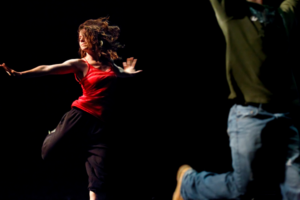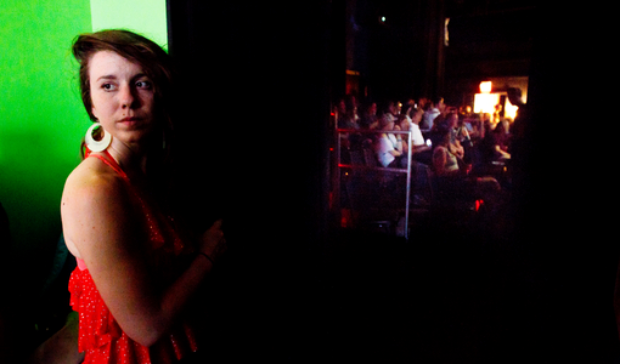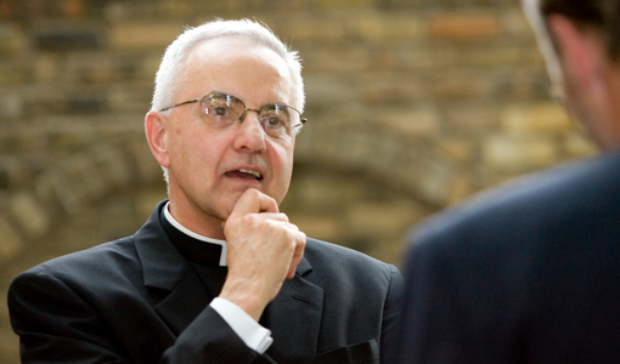When Amanda Leaveck ’10 was a senior, a friend who had studied abroad told her about the educational hardships facing children in India. Leaveck felt compelled to help. But rather than solicit support with a typical fundraiser or door-knocking campaign,Leaveck did what she does best: she produced a large-scale performing arts event.
It was an inspiring night.
On April 28, 2010, fashion designers, dancers, musicians, poets - artists from many walks of life - all brought their best performances to the main room at First Avenue where 600 people were treated to a flashy, multidisciplinary show titled "Face Forward." When all was said and done, $3,000 was raised for children in India who needed anelementary school. Along the way, Leaveck discovered that what she thought was a one-time project could become a lifelong pursuit.
Leaveck started at St. Thomas with the goal of becoming a physician. "I wanted to make a good living and I thought being a doctor was the best way to do that." After trying her hand at a few of the sciences, she decided to major in neuroscience, with a minor in dance.
While the two fields seem to be at opposite ends of the academic spectrum, to Leaveck, they fit together in an oddly perfect way. "My neuroscience classes actually affected my dancing in a good way," she said. "I learned in my neuroscience classes how the brain moves the body - I use that on a daily basis in the dance studio."
As a dancer, she found her niche as a member of Pulse, a performing arts student club on campus, and as a founding member of the Dance Club. Her work with these student organizations connected her to a network of student artists she didn’t know existed.
"I would run into people who were into photography and painting - sort of underground artists - and I’d wonder, ‘Why didn’t I know about you?’" she said. In a collaborative effort, Leaveck would work with these fledgling artists to produce multidisciplinary shows on campus - a skill that would come to help her in the future.
As a student, Leaveck also became involved with VISION, a cultural immersion program that offers students the opportunity to travel abroad to work on service projects. Through VISION, she traveled to Venezuela, Chicago, Uganda and the Virgin Islands.
"VISION trips put you in touch with who you really are," she said. "They taught me to really delve into the value of humanity." The opportunities offered by VISION for self-reflection and learning about different communities helped Leaveck gain an understanding of how to live more simply. "What I learned through VISION contributed to the energy and motivation that was needed to plan that first Face Forward event."
Taking on a project of this magnitude was no small task for a college senior trying to graduate. Leaveck immediately tapped her network of artist friends to find the top local talent to perform at Face Forward.
By a stroke of luck, Leaveck was able to book the main room at First Avenue. "To this day, I’m still not quite sure how that happened," she said. But the venue offered a much higher level of visibility that attracted a completely different level of artists.
Many disciplines were represented, including fashion designers, musicians of different genres, dancers and spoken-word artists. All volunteered their time, and each brought with them their own communities of fans and followers. It made for a diverse crowd. According to Leaveck, "There were 18-year-olds next to people my mom’s age - it was pretty cool to see that."
The production was not without its bumps and glitches. The show was initially delayed for two weeks. Yet it still managed to attract 600 people on a Wednesday night and generate enough enthusiasm among the artists that a second show was held that fall.
The second Face Forward show was more polished than its first edition. It spun off  several smaller shows that took place during the fall of 2010. But it also turned into something that was difficult for Leaveck to keep her arms around. It was time for reflection and to ask, "What is this?"
several smaller shows that took place during the fall of 2010. But it also turned into something that was difficult for Leaveck to keep her arms around. It was time for reflection and to ask, "What is this?"
Working with the network of people that helped her plan the shows, Leaveck determined that the strongest thread tying it together was the collaboration. What started out as a group of energetic young artists had evolved into an organization with two very specific goals: bringing high-quality performing arts to places with limited access in the Twin Cities and supporting the development of local talent.
Taking advantage of the buzz that surrounded the successful First Avenue productions, the organization took the name Face Forward, and Leaveck became its artistic director. "It’s a multidisciplinary collaboration bringing together different artists with completely different audiences," she said.
Since defining its mission, Face Forward has produced a number of events in the Twin Cities that have benefitted local outreach and educational organizations. The September 2011 "Move Me" event featured local poets, dancers and musicians in a multimedia benefit show for the Arizona Bridge Project, an organization that serves inner-city teenage girls who have an interest in the arts. The standing-room-only crowd witnessed documentary-style videos introducing many of the artists as they discussed the impact the collaboration has had on their work.
As Face Forward evolves, the organization is branching out. Eventually, Leaveck would like to expand Face Forward on a national scale and make it her full-time profession. "I know this is a long way down the road, but I’d love to have Face Forward be in Chicago, San Francisco and New York, with Minneapolis always being our home base," she said. "We already have someone in Denver who is interested in starting up there with lots of connections to artists."
For now, Leaveck works as an administrative coordinator with University of Minnesota Physicians to help pay the bills. She also makes sure to take time to do the things she cares about. In the summer of 2011, she founded the Arizona Dance Company. She’s also training to become a yoga instructor. What she does in her spare time helps her keep things in perspective. "If I didn’t take time to be a 23-year-old, everything else I’m trying to do would suffer."
Leaveck credits the success she’s had with Face Forward to her ability to build relationships with a diverse range of people - a skill she honed at St. Thomas. Building a network of motivated people has been key. "We survive on other people’s connections," she said. "I can’t bring 600 people together all by myself."
Read more from St. Thomas magazine





